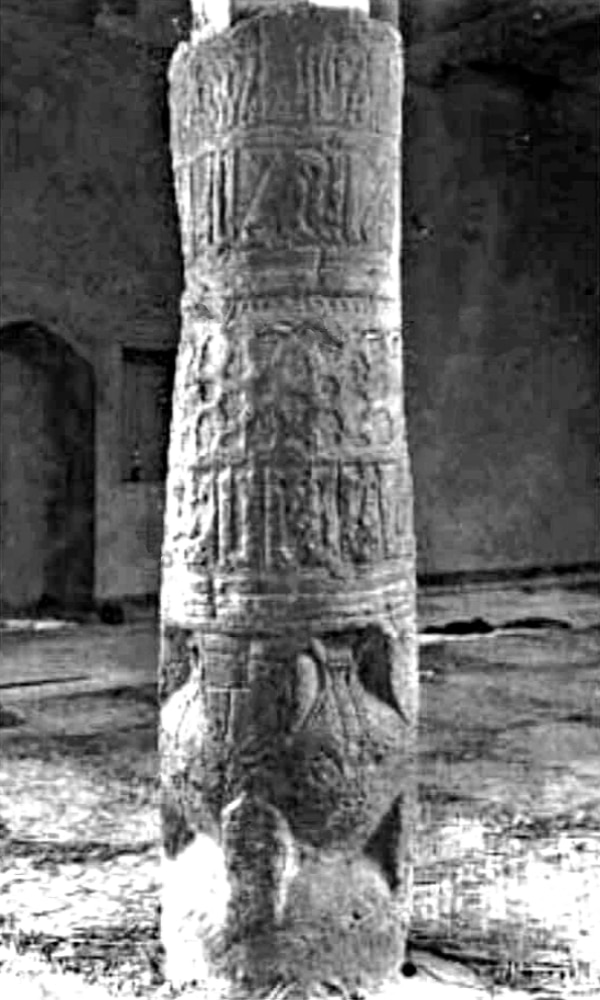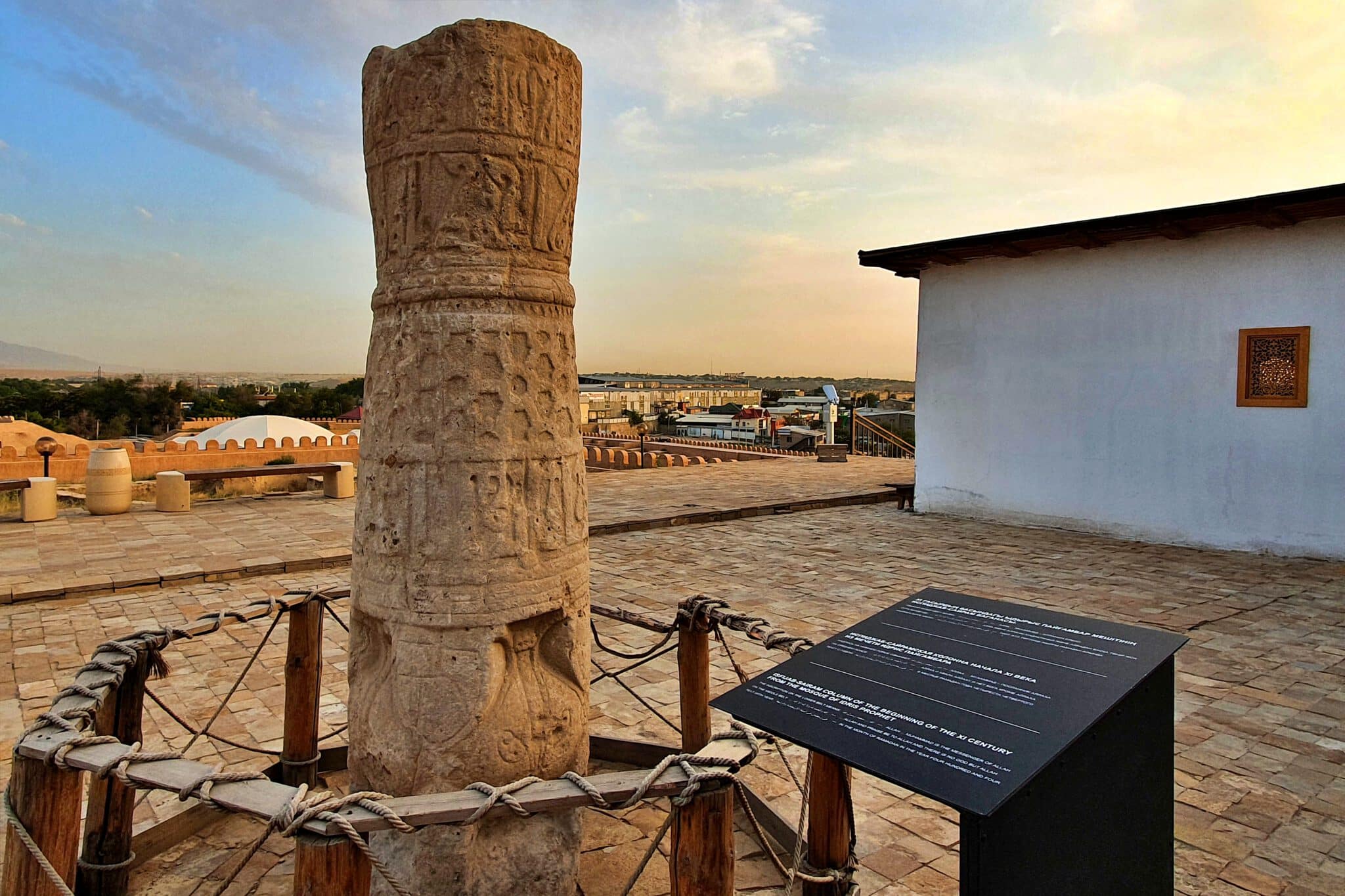The mystic stone column of Sayram
A mystic sandstone column in Sayram took the attention of historians and might be a seldom relic of the Early Islam in Central Asia.
Nestled within the ancient village of Sayram in southern Kazakhstan lies a mysterious artifact that has captivated scholars, pilgrims, and mystics alike for centuries—the stone column of the Idris-paygambara mosque. This weathered monument, carved from yellow sandstone and inscribed with Kufic Arabic script, is not just a relic of early Islamic architecture, but a silent witness to the spiritual and political upheavals that once swept across Central Asia.
A Chance Encounter in 1866
The first modern record of the column comes from the Russian writer A. K. Gaines, who encountered it during his journey through Sayram during the time of the Russian Empire in 1866. He told that inside the Idris-paygambara mosque, amidst a forest of wooden columns, stood a lone sandstone column, markedly different from the rest. It was narrow, tapering toward the middle, and bore wedge-shaped inscriptions on its capital. Intrigued, Gaines asked the local villagers about its origin. Their response was almost mythical: “This column was made by one of the sons of Adam and was not transported from anywhere, but stood here.”
Though Gaines’s companions, who interpreted the inscriptions wrongly as Old slavian letters, didn’t trusted the locals and speculated it might be a relic from the time of Tatar pogroms and was moved to Sayram, but more research proved them wrong.
A Monument of the 10th Century
Renowned Central Asian archaeologist M. Y. Masson traveled during Soviet Union time to Sayram to study the column firsthand. He described it as a 2.5-meter-high sandstone shaft, adorned with intricate Arabic inscriptions in the noble Kufic script. These inscriptions – translated later by the orientalist N.I. Veselovsky- contained common Islamic phrases such as “Allah, praise be to Allah, there is no God but Allah” and “Muhammad is the Messenger of Allah.”
For centuries, the column held deep spiritual significance for the local peopel. During the weekly Sufi dhikr ceremonies, worshippers would circle it in the Idris-paygambara with reverence. According to Masson, one touching ritual involved a young Kazakh woman seeking for luck. She rode by horse to the mosque, embraced the stone, circled it twice, and pressed her forehead to it three times—departing in the firm belief that her prayer would be answered.
Earthquake and Relocation
In the first half of the 20th century, a devastating earthquake leveled the Idris-paygambara mosque. Miraculously, the column itself survived. It was later transferred to the entrance of the Sayram Village Museum, preserving its legacy from wind and weather even after the mosque’s destruction.

Then, in 2020, this silent sentinel of Sayram’s past found a new home once again—this time in the reconstructed citadel of Shymkent. During its relocation and study, researchers made a groundbreaking discovery: an inscription bearing the date “Ramadan of the year 404,” corresponding to the year 1013 CE. This revelation likely marks the year of the mosque’s construction.
Sayram in 1013: A City Reborn
The early 11th century was a transformative period for Sayram. Just fourteen years before the mosque’s presumed construction, the Samanid dynasty lost control of the city to the powerful Kara-Khanid Khanate under the rule of the 7th Great Khagan Ahmed ibn Ali. Coins minted in Sayram in 1013 CE bear his name and call the city Medinat al-Bayda—Arabic for “White City” or “Holy City.” This suggests Sayram was not only a political center but a deeply religious one, a place of pilgrimage and spiritual learning.
This sanctified aura would soon be enhanced by the birth of Ahmad Yasawi, one of the most revered Sufi saints of the Turkic world. Born in Sayram in 1093, just 80 years after the mosque’s founding, Yasawi spent the first six years of his life in the city. His father, the Islamic cleric Sheikh Ibrahim, may have prayed and taught in the Idris Paygambara Mosque itself, perhaps the young Yasawi was sitting next to the mystical pillar and listened to his father.
A Tradition of Stone and Spirit
The Idris column is not alone in its craftsmanship. Other examples of Sayram’s medieval stone-carving art survive: one similar column resides in the prestigious Hermitage Museum in St. Petersburg, and a beautifully ornamented stone trough is displayed in the Shymkent Regional Museum of Local History. These artifacts underscore the high level of artistic and religious culture that once flourished in Sayram during the height of the Islamic Golden Age in Central Asia.
Today, the mystic column of Sayram stands in the citadel of Shymkent—a relic of faith, legend, and history. It speaks not only to the skill of ancient craftsmen, but also to the spiritual heart of a city once known as Medinat al-Bayda. In its inscriptions, we hear echoes of prayers whispered a thousand years ago. In its stone, we feel the resilience of a culture that continues to inspire reverence and awe.



